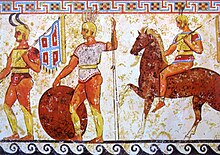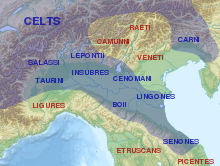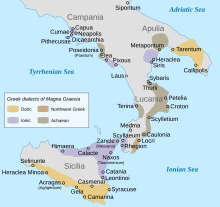List of ancient peoples of Italy
This list of ancient peoples living in
In regard to the specific names of particular ancient Italian tribes and peoples, the time-window in which historians know the historical ascribed names of ancient Italian peoples mostly falls into the range of about 750 BC (at the legendary
Nearly all of these peoples and tribes spoke
Speakers of non-Indo-European languages

Scholars believe - though sometimes on the basis of scanty evidence - that the following peoples spoke non-Indo-European languages. Some of them were Pre-Indo-Europeans or Paleo-Europeans while, with regard to some others, Giacomo Devoto proposed the definition of Peri-Indo-European (i.e. everything that has hybrid characters between Indo-European and non-Indo-European).[2]
Sardinians
- The
- Balares (Balari)[7]
- Ilienses/Iolaes/Diagesbes (Iliensi/Iolei)[7]
- Corsi (Possibly related to Ligures)[8]
Tyrrhenians
The Tyrrhenians were the Etruscans and their linguistic relatives.
- Etruscans - Centered in Etruria with later influences stretching from the Po Valley to Campania.[9][10][11][12][13][14]
- Raeti[15]
- Camunni[16]



Others (classification uncertain)
Speakers of Indo-European languages
Italo-Celtic
Italic
Speakers of Italic languages included:
- Latino-Faliscans[22]
- Latins- centered around the central plain of Italy between the Tiber and the Alban Hills.
- Romans- centered in the city of Rome.
- Falisci
- Latins- centered around the central plain of Italy between the Tiber and the Alban Hills.

- Sicels[23]
- Adriatic Veneti - centered in an area corresponding to the modern-day region of Veneto.[24]
- Umbri[25] - Centered in central Italy stretching from the Adriatic coast to the upper Tiber.

- Tyrrhenia".[26]
- Opici
- Aurunci/Ausones
- Campanians - Centered in the region of Naples
- Mamertines
- Paeligni
- Frentani - Centered on the southern Adriatic coast.
- Samnites - Centered in central Italy, south-east of Rome north-east of Capua.
- Lucani - Centered on the south-western coast of Italy.
- Bruttii
- Opici
- Oenotri
- Others
Celts
The Celts of the Italian peninsula included,
- Cisalpine Gauls - Centered in the area south of Lepontii.[31][32]

Ligures

The
were:- Ligures
Greeks

Sometimes referred in ancient sources as

Others (classification uncertain)
- Iapygians or Apulians (possibly related to Illyrians) - Centered in an area corresponding to the modern-day region of Apulia.[38]
- Elymians, who inhabited the western part of Sicily during the Bronze Age and Classical antiquity.[39][40]
Pre-Roman conquest archeological cultures
The specific identities or names of the tribes or groups of peoples that practiced these pre-Roman archeological cultures are mostly unknown. The posited existence of these archeological cultures is based on archeological

Neolithic
Copper Age
- Pre-Nuragic Sardinia
- Beaker culture
- Remedello culture
- Rinaldone culture
- Laterza culture
- Gaudo culture
- Conelle-Ortucchio culture
- Serraferlicchio culture
- Spilamberto group
Bronze Age


- Apennine culture
- Bonnanaro culture
- Nuragic civilization
- Torrean civilization
- Canegrate culture
- Proto-Villanovan culture
- Polada culture
- Castelluccio Culture
- Thapsos Culture
- Terramare culture
- Castellieri culture
- Luco-Meluno culture
- Scamozzina culture
Iron Age
- Hallstatt culture
- La Tène culture
- Villanova culture
- Latial culture
- Este culture
- Golasecca culture
- Camunni culture
- Fritzens-Sanzeno culture
Genetics

A genetic study published in
See also
| Ancient history |
|---|
| Preceded by prehistory |
|
- Prehistoric Italy
- Genetic history of Italy
- List of ancient Italic peoples
- List of Nuragic tribes
- History of Italy
- History of the Mediterranean region
- Etruscan civilization
- Pre-Nuragic Sardinia
- Nuragic civilization
- Latins (Italic tribe)
- Prehistory of Corsica
- Prehistory of Malta
- History of Sardinia
- History of Sicily
- List of Celtic tribes
- List of ancient Germanic peoples
- List of ancient Greek tribes
- List of ancient Iranian peoples
- Italo-Celtic
- Magna Graecia
- Rock Drawings in Valcamonica
- Osco-Umbrian languages
- Roman Kingdom
- Founding of Rome
- Aeneid
- Old Latium
References
- ^ "Sicilian Peoples: The Carthaginians - Best of Sicily Magazine - Carthaginians, Phoenicians, Hanibal, Hamilcar, Punic Wars, Punic Language, Carthage, Palermo, Zis, Sis, Panormos, Solus, Motya, Motia, Mozia". www.bestofsicily.com. Retrieved 2022-02-09.
- ^ Giacomo Devoto, Gli antichi Italici, Firenze, Vallecchi, 1931.
- ^ "sardi in "Dizionario di Storia"". www.treccani.it.
- ^ "SARDI in "Enciclopedia Italiana"". www.treccani.it.
- ^ "ARCHIVIO. Nuovo studio dell'archeologo Ugas: "È certo, i nuragici erano gli Shardana"". Sardiniapost.it. February 3, 2017.
- ^ "SP INTERVISTA>GIOVANNI UGAS: SHARDANA". www.sardiniapoint.it.
- ^ a b "LacusCurtius • Ptolemy's Geography — Book III, Chapter 3". penelope.uchicago.edu.
- ISBN 978-88-89661-00-0.
- ISBN 978-1901663907.
- ISBN 0-7156-3162-4.
- ^ Camporeale, Giovannangelo, ed. (2001). The Etruscans Outside Etruria. Translated by Hartmann, Thomas Michael. Los Angeles: Getty Trust Publications (published 2004).
- ^ Etruria campana
- ^ Strabo. Geography. Book V, Chapter IV. Perseus Digital Library. Tufts University. Archived from the original on 2 September 2022. Retrieved 2 September 2022.
- ^ Francesco Belsito (2013). Storia di Nocera. Monumenti, personaggi, leggende. Angri, Gaia.
- ISBN 9781444337341.
- ^ Markey, Thomas (2008). Shared Symbolics, Genre Diffusion, Token Perception and Late Literacy in North-Western Europe. NOWELE.
- ^ Piceni popolo d'Europa, Vv.Aa., Edizioni De Luca, Roma, 1999, p. 139
- ^ Hazlitt, William. The Classical Gazetteer (1851), p. 297.
- ^ Pietrina Anello. "I Sicani nel IV secolo a.C.". Atti del convegno di studi su Diodoro Siculo e la Sicilia indigena (in Italian) (2005): 150.
- ^ "Liguri". Enciclopedie on line. Treccani.it (in Italian). Rome: Treccani -Istituto dell'Enciclopedia Italiana. 2011.
Le documentazioni sulla lingua dei Liguri non ne permettono una classificazione linguistica certa (preindoeuropeo di tipo mediterraneo? Indoeuropeo di tipo celtico?).
- ^ "Ligurian language". Britannica.com. 2014-12-16. Retrieved 2015-08-29.
- ^ Villar, cit., pp. 447-482.
- S2CID 242076323.
- ^ Storia, vita, costumi, religiosità dei Veneti antichi at www.venetoimage.com (in Italian). Accessed on 2009-08-18.
- ^ "L'alfabeto umbro su Omniglot.com". 16 January 2009.
- ^ Aristotle (1932). "vii.10". Politics.
- ^ Pliny the Elder. "Book III, Chapter 12". Natural History.
- Ab urbe condita, 2.22
- ^ Strabo (1917). "Book V, Chapter 4, Section 2". Geography.
- ^ G. Micali, Storia degli antichi popoli italiani, Tomo II, Firenze 1832, p. 24.
- ^ Kruta, Venceslas (1991). The Celts. Thames and Hudson. pp. 52–56.
- ^ Stifter, David (2008). Old Celtic Languages (PDF). pp. 24–37.
- ^ "LinguistList: Lepontic". Archived from the original on 2011-12-22. Retrieved 2010-06-06.
- ISBN 978-1-85109-440-0
- ^ "Liguri". Enciclopedie on line. Treccani.it (in Italian). Rome: Treccani -Istituto dell'Enciclopedia Italiana. 2011.
Le documentazioni sulla lingua dei Liguri non ne permettono una classificazione linguistica certa (preindoeuropeo di tipo mediterraneo? Indoeuropeo di tipo celtico?).
- ^ "Ligurian language". Britannica.com. 2014-12-16. Retrieved 2015-08-29.
- ^ Herodotus, Histories, ΚΛΕΙΩ 1.56.2: μετὰ δὲ ταῦτα ἐφρόντιζε ἱστορέων τοὺς ἂν Ἑλλήνων δυνατωτάτους ἐόντας προσκτήσαιτο φίλους. ἱστορέων δὲ εὕρισκε Λακεδαιμονίους τε καὶ Ἀθηναίους προέχοντας, τοὺς μὲν τοῦ Δωρικοῦ γένεος, τοὺς δὲ τοῦ Ἰωνικοῦ. ταῦτα γὰρ ἦν τὰ προκεκριμένα, ἐόντα τὸ ἀρχαῖον τὸ μὲν Πελασγικόν
Translation: Then he set out to examine who among the "Greeks" were the strongest, whom he could make friends with. And searching, he found that the Lacedaemonians and the Athenians were distinguished, the former among the Dorians, the latter among the Ionians. Because these nations were the best known, being in the old days the last Pelasgian [1] - ^ "IAPIGI" (in Italian). Retrieved 3 July 2023.
- ^ "Gli Elimi: storia e archeologia di Segesta, Erice, Entella". www.arkeomania.com. Retrieved 2021-12-26.
- ISBN 978-88-8268-029-9.
- ^ Antonio et al. 2019, Table 2 Sample Information, Rows 29-32, 36-37.
- ^ Antonio et al. 2019, p. 2.
- ^ Antonio et al. 2019, p. 3.
Bibliography
- Antonio, Margaret L.; et al. (November 8, 2019). "Ancient Rome: A genetic crossroads of Europe and the Mediterranean". PMID 31699931.
External links
- "Languages and Cultures of Ancient Italy. Historical Linguistics and Digital Models", Project fund by the Italian Ministry of University and Research (P.R.I.N. 2017)
